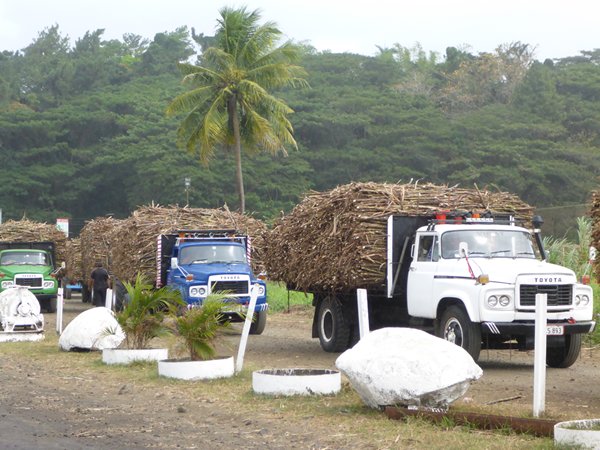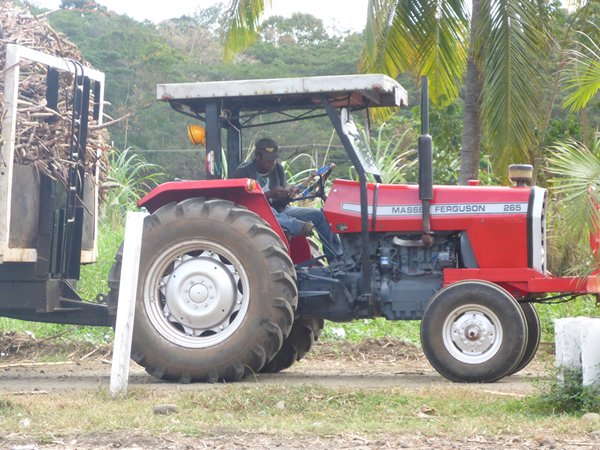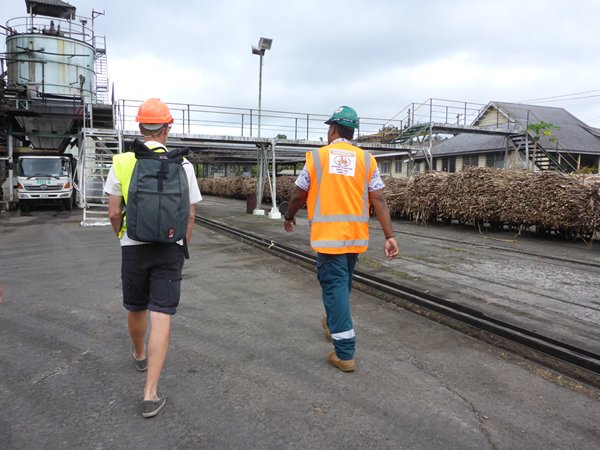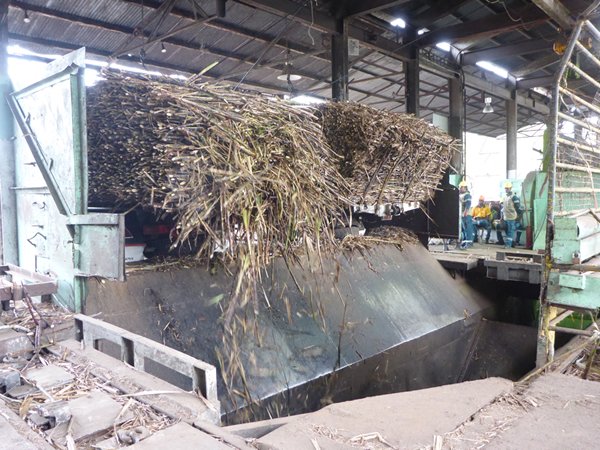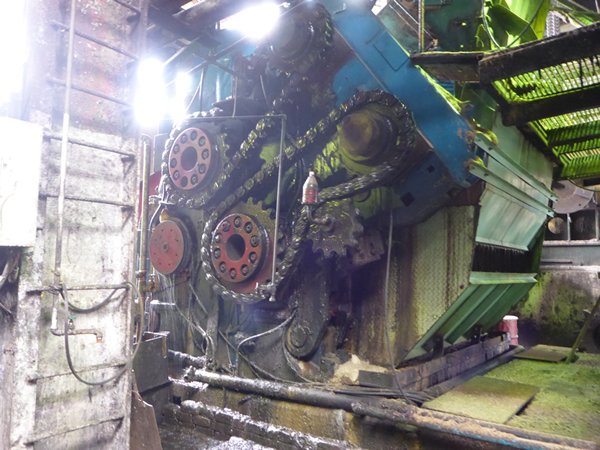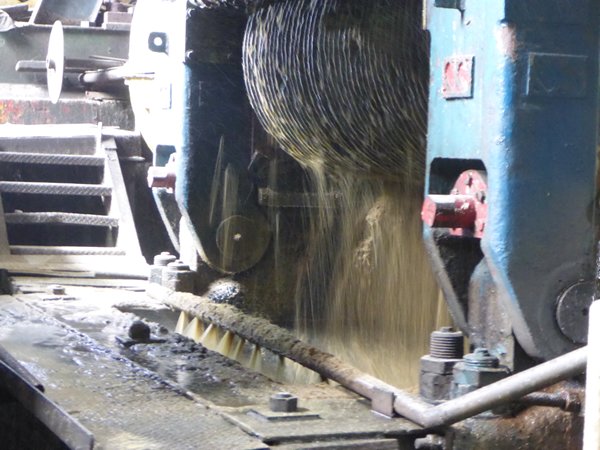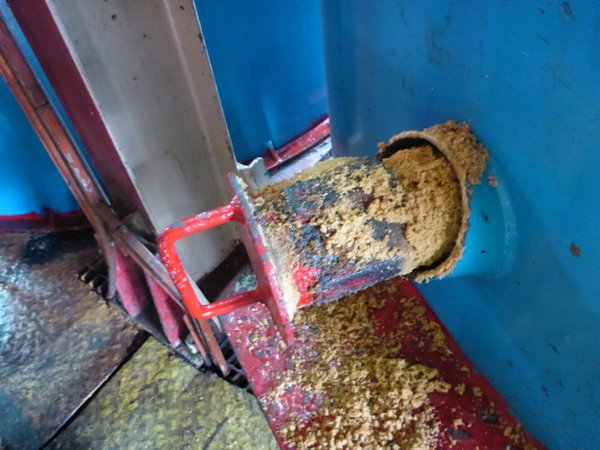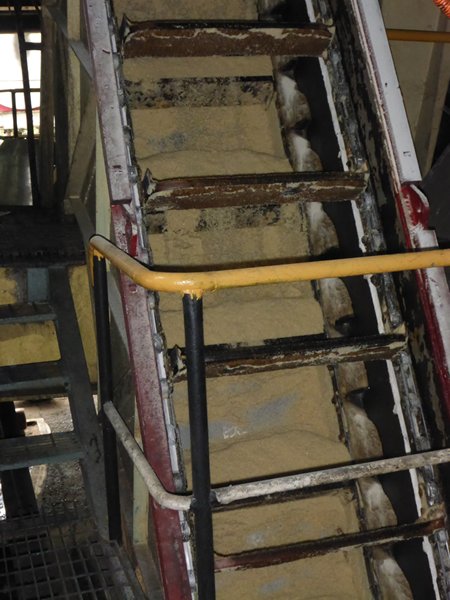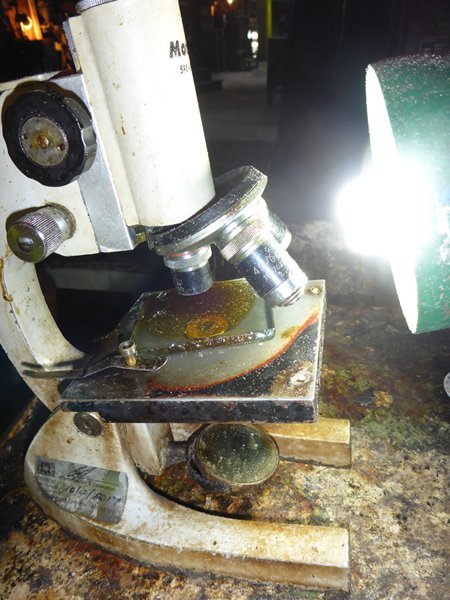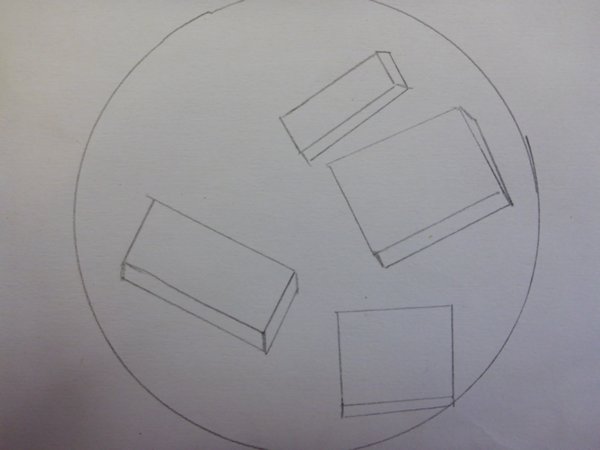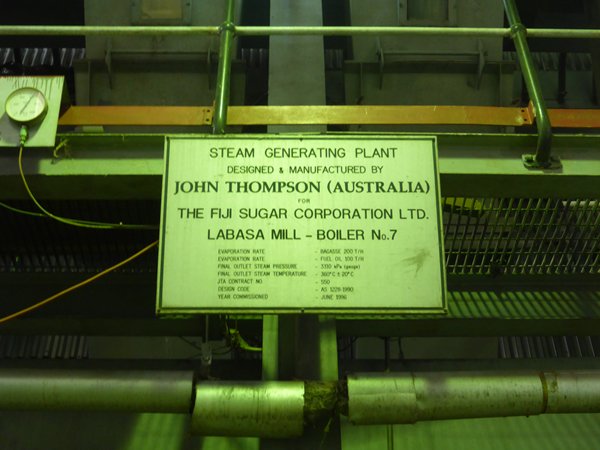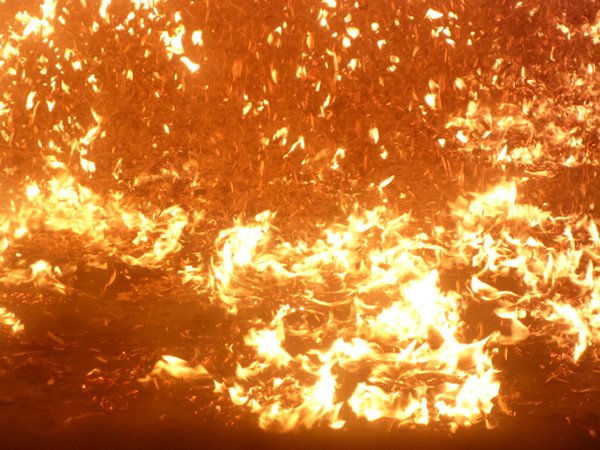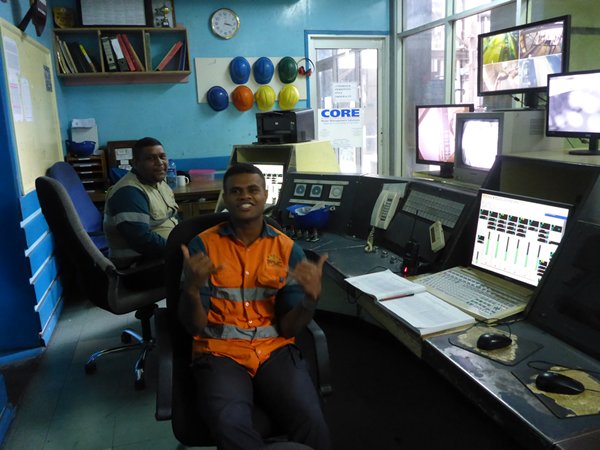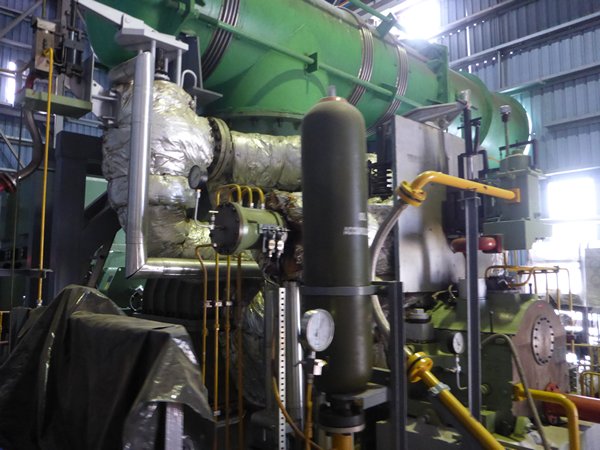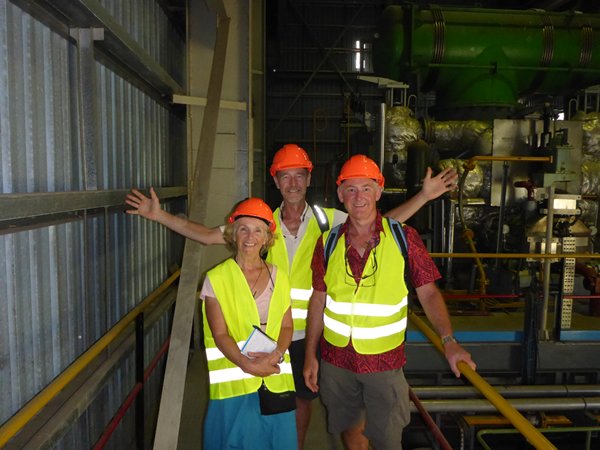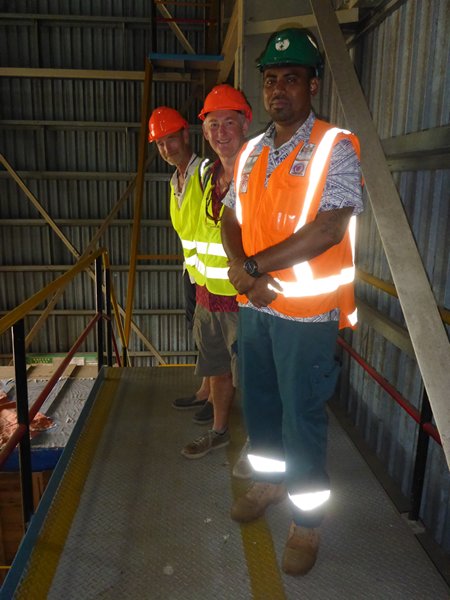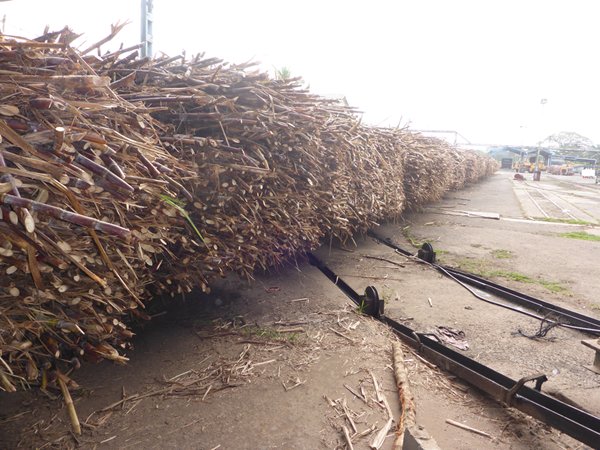Sugarcane Harvest Time

|
Sugarcane Harvest Time In Vanua Levu It had taken some organising with Jaswan, senior employee of the Fiji Sugar Corporation Mill 5 minutes by taxi north east out of Labasa (pron: Lanbasa), but finally he was ready to show us around. He started at the mill as an apprentice 14 years ago and there wasn’t much he didn’t know. This is one of four mills in Fiji incorporated in 1972 with the Government holding 68% of the shares and employing 3000 people directly, in total. Another 200,000 or more people depending on it for their livelihood, mainly farming the rural sugar belts of Fiji. The action started after an entertaining two hour wait sitting at the main gate watching the 100 or so queue of trailer loads of cane, hand macheteed stems from the hillsides and shorter more sliced caged loads severed by one of the 20 mill owned machines working on the flatlands, all waiting patiently to move through to the weighbridge. I now reflect on our good fortune of that afternoon because the six month harvest season is in full swing, the mill working flat out 24/7 to get the raw cane milled ready for shipment to Lautoka on the other island for packing and shipping onto the world market. Much of Europe is now sugar independent, including the UK with its beet production, so ex-colony but still Commonwealth member Fiji has had to do some careful marketing to stay in business. We saw it all at their busiest time of production. The loads of raw cane are brought to the waiting lane by the farmers driving well loved and cared for Massey Ferguson tractors and Toyota trucks painted so thoroughly they look like new. Production in a kinder paced, post slavery era of small plantation land ownership. The wheel hubs spray painted silver and one even had red painted nuts. The drivers can wait in their cabs overnight if there is a break down in production, as there had been the night before. They proceed to the ‘weigh in’ in a quota system, measuring the machined crop fairly with the hand chopped loads, which answers my earlier query about the two different types of load. Despite being hot and tired almost every driver had a wave and welcome for us, as curious no doubt about these three distinctly white strangers as we were curious about their lives too. On our bus ride in we had noticed the men working in the plantations west of Labasa and spotted the narrow gauge railway in use for over 100 years that still carts nearby loads into the mill from the more accessible plantations. “Make sure your tunics are done up and your hats are tight” Jaswan warned, “The ground is uneven and watch your heads.” “May I take photos?” “You can but not for any publication.” I wasn’t sure what his worry was but as this blog site has exclusive access I think we can go ahead and publish here. The factory is a mixture of old, newer and new production machinery and an international combination of design, manufacture and installation. Walking through areas where the noise and smell of industry worked alongside the history of rotting steelwork was something I had never come across before, being more used to old factories closing and completely new ones being built nearby. This process of gradual renewal maybe reduced the need for large scale investment and expensive loans. It also accounts for why there is no sugar museum, the factory is a working and transforming museum. Near 600 employees keep the production going here this time of year and in the other six months, when the maintenance, repairs and building is done that number reduces by only 100 hundred. Nice work if you can get it. All the helmeted workers we came across came forward to shake our hands as Jaswan introduced us. We walked across the route taken by the trucks from the weighbridge to where their loads are tipped onto the conveyor belt that trundles up to the mighty (scary) crusher. The drivers’ vehicles are then re-weighed and the value of their load assessed, then they can go home, on this Friday 13th afternoon, Black Friday! Watching the sugar juice pouring brown from the crushed stems was satisfying. The squeezed dry residue (bargasse, there’s a new one for you Scrabblers) is stockpiled into a flat topped mountain just outside and powers the massive boiler to produce potentially enough electrical energy to power all of Fiji. In the control room we were introduced to two happy men who had pleasant but technical and responsible jobs controlling the machine, watching the numerous production monitors and generally working in a cool, clean, air-conditioned environment! We explored the production process in the reverse order because that was the safest route in and back out for us. Up and down metal stairways, avoiding suspect puddles of liquid and ducking under hot pipes we couldn’t help but imagine that our visit would not have been allowed back in Health and Safety overly conscious Britain, so here we were very fortunate. At times the noise was so great Jaswan spoke to just one of us with the correct assumption we would exchange mental notes later. After crushing the liquid is washed, strained and cleared before being pumped into the evaporators. Jaswan opened a plug in the bottom of one and invited us to taste the sugar sticking to it. Soft brown sugar. Imagine the heat required from the boilers to evaporate all that liquid. Then things really start to hot up when the sugar is boiled until the crystals are a regular shape. Now here’s a job I could have been quite good at. Taking samples of the boiled sugar crystals, making a slide and looking at it under a microscope. Beautiful but uneven crystals in either square or rectangular shapes. They have to be even in size and shape before they are ready for shipment to the other island. My attempt at photographing them failed because I offered the wrong part of the camera to the scope and didn’t want to keep everyone waiting so I will try to draw what we saw. Then the uniformly shaped sugar crystals go into what look like centrifuges where it is spun to extract any moisture which becomes molasses. Our tour ended in the generator room with the 10 megawatt (megabig!) beauty purring away nicely. Then even more drama came our way. The school trip that we were due to accompany arrived and hour late and then Jaswan decided on conducting our personal tour after the school visit which accounts for our two hour wait sitting on benches at the entrance. So instead of having two hours back in Labasa, making a planned purchase in the Handicraft market, enjoying a leisurely bite at the Hare Khrishna restaurant we had relaxed in before and generally being in plenty of time for the bus at 4.00pm., Jasman told us we would be quicker walking back into town because of the very slowly moving traffic queue working in the direction in which we needed to go rather quickly, it being 3.40pm already. “No taxi will come out here with that queue.” He said when we asked if he could arrange one. I can do it, I don’t like to but I can walk very quickly. Mark and I pondered for a few seconds on whether we would get back to the bus station before the empty taxi we spied crawling along at my usual walking pace with many rests. “We need to catch the 4.00pm bus for Savusavu please,” I said, then added “If we miss it would you be prepared to drive after it until we catch it?” Now he was my kind of guy, liked a challenge, the sort who’d struggle through a storm with you, maybe. So we relaxed nervously. Two smart school boys started walking our way so we could monitor how we would be doing had we walked. It was about even Stevens. “There’s your bus.” the driver exclaimed with glee. We needn’t have worried, in the dense mass of moving humanoids it took us 20 minutes to get out of the bus station. I turned as I boarded the bus to see our man the taxi driver watching with concern and a smile to see we made it. A quick wave and he was gone. The ‘air conditioning’ was on, doors and windows open and there wasn’t even standing room. People who were sitting could have their bags on their knees but the driver was strict on the folk standing to put bags in the racks so more could board. A young school girl insisted I take her seat and this is common practice. The boys had to stand for the first half of the journey. School children have much respect for their elders. I was on a seat for three with a large lady on one side and a back pack on my left shoulder, there was no more room in the racks. All was well we had made it. The driver adopted a no braking downhill policy, (well they would only overheat anyway I guess) which was interesting on the bends when my hand would grab the seat infront in perfect unison with the lady next to me and the boys knuckles turned white. At one point little fingers gently tapped my arm, I turned and two lovely big brown eyes looked at me. I smiled back and said “Hello, what’s your name?” A little young to reply so I just held and gently shook her fingers by way of an ‘I’d like to be your teacher, kind of thing’. As soon as we get out of Labasa the bus will empty I thought so everyone can have a seat. Well not exactly as some got off more school children boarded and had to stand for their journey. It was a novelty for us but imagine this every day! It wasn’t until the outskirts of Savusavu that we could stretch out a bit, then into the local Chinese where we were saved from starvation with a delicious meal and our thirst quenched with beer, water and a champagne glass filled to the brim with Chardonnay. Back on board, checking our emails we found Alison and Randall had arrived in Tregoning on a mooring a few feet away, so more adventures are afoot methinks!
|
